Alternative names Stir-fried rice cakes Variations Gungjung-tteok-bokki | Type Bokkeum Place of origin Korea | |
 | ||
Main ingredients Tteok (rice cakes), Kamaboko (fish cakes), Gochu-jang (chili paste) Similar Gimbap, Tteok, Mandu, Sundae, Kimchi | ||
Tteok-bokki (떡볶이) or stir-fried rice cakes is a popular Korean food made from small-sized garae-tteok (long, white, cylinder-shaped rice cakes) called tteokmyeon (떡면; "rice cake noodles") or commonly tteok-bokki-tteok (떡볶이 떡; "tteok-bokki rice cakes"). Fish cakes, boiled eggs, and scallions are one of the most commonly added ingredients. It can be seasoned with either spicy gochujang (chili paste) or non-spicy ganjang (soy sauce)-based sauce; the former being the prototype, and the latter often called gungjung-tteok-bokki (royal court tteok-bokki). Nowadays, variations also include curry-tteok-bokki, cream sauce-tteok-bokki, jajang-tteok-bokki, seafood-tteok-bokki, galbi-tteok-bokki and so on. Tteok-bokki is commonly purchased and eaten at bunsikjip (snack bars) as well as pojangmacha (street stalls).
Contents
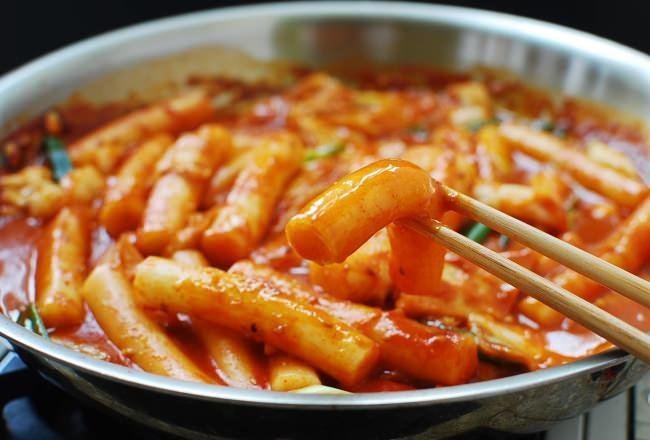
History
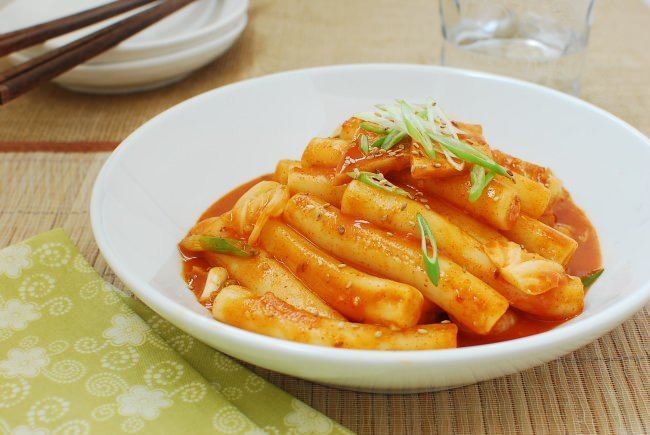
The first record on tteok-bokki appears in Siuijeonseo, a 19th century cookbook, where the dish was listed using the archaic spelling steokbokgi (복기). According to the book, tteok-bokki was called by various names including tteokjjim (steamed rice cakes), tteok-japchae (stir-fried rice cakes), and tteok-jeongol (rice cakes hot pot). The royal court version was made from white tteok (rice cakes), sirloin, sesame oil, soy sauce, scallions, rock tripe, pine nuts, and toasted and ground sesame seeds, while the savory, soy sauce-based tteok-bokki was made in the head house of Papyeong Yun clan, where good-quality soy sauce was brewed. In this version, short ribs among others was a common ingredient. The name tteok-bokki also appears in the revised and enlarged edition of Joseon Yori Jebeop, where it is described as a soy sauce-based savory dish.
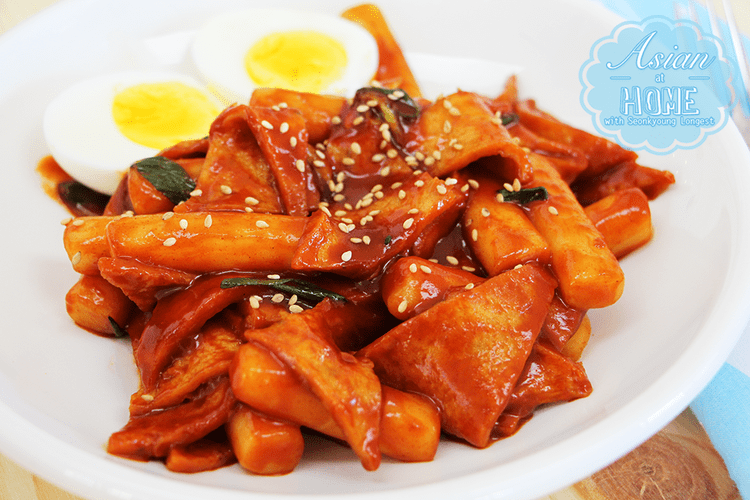
It is believed that red, spicy tteok-bokki with gochu-jang (chili paste)-based sauce first came up in 1950s, and was popularized in 1970s. As it was a folksy food for working class people, wheat tteok often substituted the rice ones. Sindang neighborhood in Seoul, where the spicy tteok-bokki was first sold, is still famous for its tteok-bokki alleys. Nowadays, typical tteok-bokki purchased and eaten at bunsikjip (snack bars) and pojangmacha (street stalls) are red and spicy, while the soy sauce-based non-spicy version is referred to as gungjung-tteok-bokki (궁중떡볶이; "royal court tteok-bokki"). Rice tteok regained popularity with the economic development, and various versions of the dish have proliferated in South Korea and in the world.
Varieties
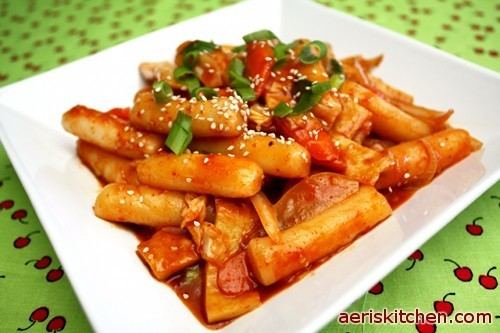
Just like other types of popular food, tteok-bokki went through various fusions. In addition to the traditional add-ons such as boiled eggs and pan-fried mandu (dumplings), various ingredients such as seafood, short ribs, instant noodles, chewy noodles are also added to the dish, in which case the dish is called haemul-tteok-bokki, (해물떡볶이; "seafood tteok-bokki"), galbi-tteok-bokki (갈비떡볶이; "short ribs tteok-bokki"), ra-bokki (라볶이; "instant noodles tteok-bokki"), jjol-bokki (쫄볶이; "chewy noodles tteok-bokki"), and so on. Non-soy sauce- or chili paste- based tteok-bokki sauce also gained popularity. Some well-known variations include curry-tteok-bokki, cream sauce-tteok-bokki, and jajang-tteok-bokki. Fusion dishes such as tteok-bokki-gratin are also popular.

Jeongol (hot pot)-type tteok-bokki is called jeukseok-tteok-bokki (즉석떡볶이; "on-the-spot tteok-bokki"), and is boiled on the table-top stove during the meal. A variety of add-ons, such as vegetables, mandu (dumplings), and ramyeon or udong noodles are available at jeukseok-tteok-bokki restaurants. As jeukseok-tteok-bokki is usually a meal rather than a snack, bokkeum-bap (fried rice) is also a common end-of-meal add-on.
Gochu-jang tteok-bokki
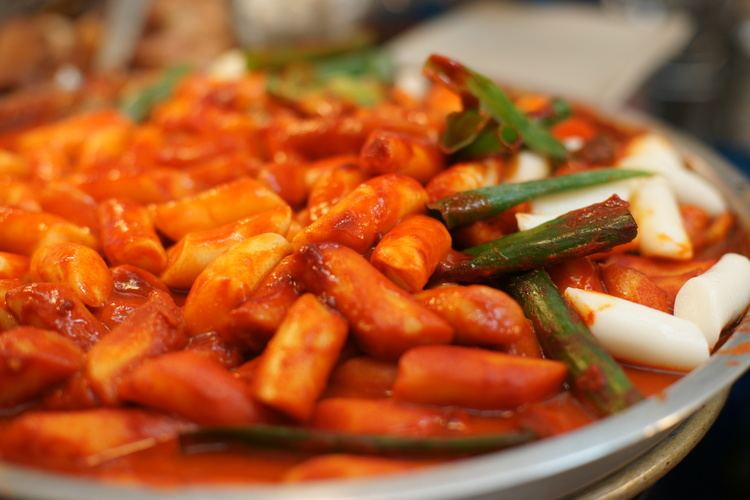
Riquant, red gochu-jang-based tteok-bokki is one of Koreans' favorite snacks. Both soupy gungmul-tteok-bokki (국물떡볶이; "soup tteok-bokki") and dry gireum-tteok-bokki (기름떡볶이; "oil tteok-bokki") are commonly enjoyed, while the former is considered as the prototype. In gungmul-tteok-bokki, kelp-anchovy stock is often used to bring out the savory flavor. Gochutgaru (chili powder) is often added for additional heat and color, while mullyeot (rice syrup) helps with sweetness and consistency. Eomuk (fish cakes), boiled eggs, and diagonally sliced scallions are common addition to the dish. In gireum-tteok-bokki, the mixture of gochutgaru (chili powder), soy sauce, sugar, and sesame oil often replaces gochu-jang (chili paste). Soft tteok sticks are seasoned with the sauce mixture, then stir-fried in cooking oil with a handful of chopped scallions and served. Tongin Market in Jongno, Seoul is famous for gireum-tteok-bokki.
Ganjang tteok-bokki
Sweet and savory, brown soy sauce-based tteok-bokki is often referred to as gungjung-tteok-bokki (궁중떡볶이; "royal court tteok-bokki"). Its history dates back to a royal court dish before the introduction of chili pepper, which happened in the late Joseon era. Having similar taste to japchae (stir-fried glass noodles and vegetables), it was enjoyed by the royals as a banchan and as a snack. Although traditional tteok-bokki was made with soup soy sauce, which is the traditional (and was the only) type of soy sauce in the pre-modern Korea, sweeter regular soy sauce has taken its place in modern time. Other traditional ingredients such as sirloin or short ribs, sesame oil, scallions, rock tripe, pine nuts, and toasted and ground sesame seeds are still commonly used in modern gungjung-tteok-bokki. Other ingredients such as mung bean sprouts, carrots, onions, dried Korean zucchini, garlic, and pyogo mushrooms are also frequently used. The dish is usually served with egg garnish.
